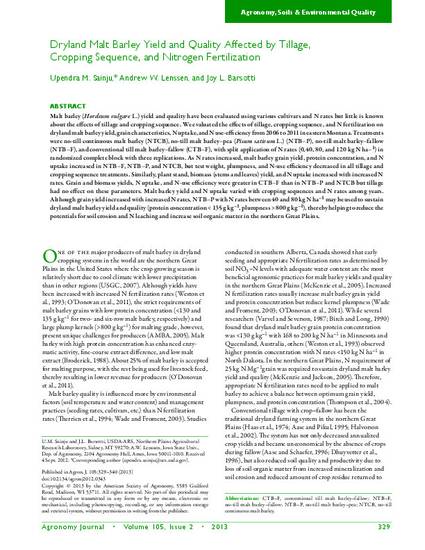
Malt barley (Hordeum vulgare L.) yield and quality have been evaluated using various cultivars and N rates but little is known about the effects of tillage and cropping sequence. We evaluated the effects of tillage, cropping sequence, and N fertilization on dryland malt barley yield, grain characteristics, N uptake, and N use-efficiency from 2006 to 2011 in eastern Montana. Treatments were no-till continuous malt barley (NTCB), no-till malt barley–pea (Pisum sativum L.) (NTB–P), no-till malt barley–fallow (NTB–F), and conventional till malt barley–fallow (CTB–F), with split application of N rates (0,40, 80, and 120 kg N ha–1) in randomized complete block with three replications. As N rates increased, malt barley grain yield, protein concentration, and N uptake increased in NTB–F, NTB–P, and NTCB, but test weight, plumpness, and N-use efficiency decreased in all tillage and cropping sequence treatments. Similarly, plant stand, biomass (stems and leaves) yield, and N uptake increased with increased N rates. Grain and biomass yields, N uptake, and N-use efficiency were greater in CTB–F than in NTB–P and NTCB but tillage had no effect on these parameters. Malt barley yield and N uptake varied with cropping sequences and N rates among years. Although grain yield increased with increased N rates, NTB–P with N rates between 40 and 80 kg N ha−1 may be used to sustain dryland malt barley yield and quality (protein concentration < 135 g kg−1, plumpness > 800 g kg−1), thereby helping to reduce the potentials for soil erosion and N leaching and increase soil organic matter in the northern Great Plains.
Available at: http://works.bepress.com/andrew_lenssen/14/

This article is from Agronomy Journal 105 (2013): 329–340, doi:10.2134/agronj2012.0343.